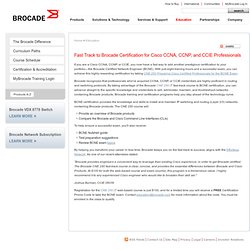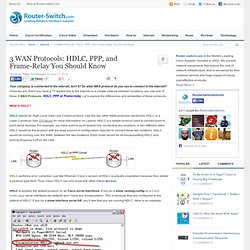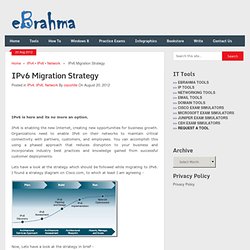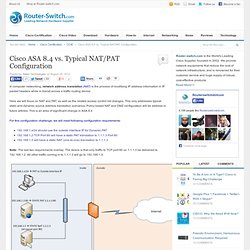

Education. If you are a Cisco CCNA, CCNP, or CCIE, you now have a fast way to add another prestigious certification to your portfolio—the Brocade Certified Network Engineer (BCNE).

With just eight training hours and a successful exam, you can achieve this highly rewarding certification by taking CNE 250 Preparing Cisco Certified Professionals for the BCNE Exam. Brocade recognizes that professionals who've acquired CCNA, CCNP, or CCIE credentials are highly proficient in routing and switching protocols. By taking advantage of the Brocade CNE 250 fast-track course to BCNE certification, you can advance straight to the specific knowledge and credentials to sell, administer, maintain, and troubleshoot networks containing Brocade products.
Brocade training and certification programs help you stay ahead of the technology curve. CCNP Exam Prep Tips and Must Knows. Home » CCNP, Certification, Cisco, Technology Author: Carol Kavalla8 April 20132,178 viewsNo CommentsTags: ccnp exam prep Things You’ll Need to Know about OSPF: OSPF is a link state routing protocol that requires a hierarchical network structure Transit Area – Area 0 (Also called Backbone Area)Normal areas – non-transit areas Types of OSPF Routers: Backbone Router – A router with all interfaces in Area 0Internal Router – a router with all interfaces in a non-backbone areaABR – Area Border Router – A router that connects Area 0 to non-backbone areaASBR – connects any OSPF area to a different routing administration.

OSPF uses cost as a metric. This is configurable with the auto-cost reference-bandwidth command (config-router) OSPF Tables: Neighbor TableLink State DatabaseRouting Table OSPF Adjacencies: Routing updates and topology information are passed only between adjacent routersForming OSPF adjacencies on LAN links is different from forming them on point to point links OSPF Packet Types. Cisco CCNA, CCENT, ICND1, ICND2, CCNP, Online Training Classes. Connecting People, Words & Ideas. CCNA. CCNA Labs: Subnetting Skills Challenge (Cisco CCNA2 Routing Protocols and Concepts Ch3) Part1. CCNA Labs: Subnetting Skills Challenge (Cisco CCNA2 Routing Protocols and Concepts Ch3) Part1. CCNA - 640-822 - Subnetting. CCNP or Bust! 3 WAN Protocols: HDLC, PPP, and Frame-Relay You Should Know » Router Switch Blog. Your company is connected to the Internet, isn’t it?

So what WAN protocol do you use to connect to the Internet? Chances are, that if you have a T1 leased line to the Internet or a private network between locations, you use one of these 3 WAN Protocols: HDLC, PPP, or Frame-relay. Let’s explore the differences and similarities of these protocols. What is HDLC? HDLC stands for High-Level Data Link Control protocol. HDLC performs error correction, just like Ethernet. HDLC is actually the default protocol on all Cisco serial interfaces.
What is PPP? You may have heard of the Point to Point Protocol (PPP) because it is used for most every dial up connection to the Internet. The differences between PPP and HDLC are: PPP is not proprietary when used on a Cisco routerPPP has several sub-protocols that make it function.PPP is feature-rich with dial up networking features Because PPP has so many dial-up networking features, it has become the most popular dial up networking protocol in use today.
How To Virtualize A CCNA Lab With GNS3. CCNA Training. CCNA Syllabus. The CCNA R&S certification validates the ability to install, configure, operate, and troubleshoot medium-size routed and switched networks.

CCNA certified professionals have the knowledge and skills to make connections to remote sites via a WAN, and mitigate basic security threats. CCNA R&S training covers (but is not limited to) the use of these topics: IOS, IPv6, IPv4, OSPF, Cisco Licensing, Enhanced Interior Gateway Routing Protocol (EIGRP), Serial Line Interfaces, Frame Relay interfaces VLANs, Ethernet, VLSM, and basic traffic filtering.
Partners: Log in for Partner Education Connection (PEC) curricula. Exams & Recommended Training. Tutorial CISCO CCNA. CCNA Security. The CCNA Security certification is an entry-level IT certification in the Cisco security world.

It is also a great certification for start a security path in general. The Cisco certifications are designed to give you as much knowledge as possible about the basics and then show you how to implement the knowledge on Cisco devices. CCNA Security covers basic topics about Cisco routers, switches, firewalls and intrusion prevention systems. It is a good place to start for more advanced certifications like CCNP Security. What Exams You Must Pass to Become a CCNA Security. Free Cisco Catalyst Switch Lab. Subnetting Made Easy by Cisco Networking Academy Student Brian Morgan. Cisco Video Labs in English. VLAN Trunking Protocol (VTP) & VTP Modes » Router Switch Blog. What is a VLAN Trunking Protocol (VTP)?

“VTP allows a network manager to configure a switch so that it will propagate VLAN configurations to other switches in the network” VLAN Trunking Protocol (VTP) is a Cisco proprietary Layer 2 messaging protocol that manages the addition, deletion, and renaming of VLANs for the Cisco Catalyst Switches in the same VLAN Trunking Protocol (VTP) domain. VLAN Trunking Protocol (VTP) enables Cisco Catalyst Switches to exchange and maintain consistent VLAN information amongst a group of Cisco Catalyst Switches. For example, information for the VLAN 50 defined in Cisco Catalyst Switch A is propagated via VTP updates to all other Cisco Catalyst Switches (Switches B, C and D) in the same VTP domain, the other Cisco Catalyst Switches B, C and D will all end up adding VLAN 50 in their local VLAN data base.
VTP is available on most of the Cisco Catalyst Family products. The comparable IEEE standard in use by other manufacturers is GVRP. How Private VLANs Work? Evolves Associate-Level Certifications, Redesigns CCNA Routing and Switching Certification to Support Next-Generation Job Roles. Certification and Training Updates Meet Market Demand for Networking Talent Aligned With Changing Business Requirements SAN JOSE, Calif., March 26, 2013 – Continuing its commitment to deliver job-ready training, best practices and the most up-to-date information on the latest networking solutions, Cisco today announced a redesign of the Cisco® associate-level certification programs and the evolution of the CCNA® certification to CCNA Routing and Switching certification. While more than 99 percent of things in the physical world today are still not connected to the Internet, the phenomenon called "the Internet of Everything" will soon wake up everything imaginable.
As the network evolves and changes, becoming more sophisticated, the job roles of network engineers also continue to change. Key Facts Supporting Quotes Availability. IPv6 Migration Strategy « eBrahma. IPv6 is here and its no more an option.

IPv6 is enabling the new Internet, creating new opportunities for business growth. Organizations need to enable IPv6 on their networks to maintain critical connectivity with partners, customers, and employees. You can accomplish this using a phased approach that reduces disruption to your business and incorporates industry best practices and knowledge gained from successful customer deployments. Lets have a look at the strategy which should be followed while migrating to IPv6.
I found a strategy diagram on Cisco.com, to which at least I am agreeing - Now, Lets have a look at the strategy in brief - Business and Network Discovery The first step toward deployment is business and network discovery, where an organization identifies high-level business requirements for the migration, including timing, as well as external considerations such as regional address availability and government compliance.
Deployment Assessment. Cisco ASA 8.4 vs. Typical NAT/PAT Configuration » Router Switch Blog. In computer networking, network address translation (NAT) is the process of modifying IP address information in IP packet headers while in transit across a traffic routing device.

Here we will focus on NAT and PAT, as well as the related access control list changes. This only addresses typical static and dynamic source address translation scenarios. Policy based NAT and DMZ configuration will be address in future articles. This is an area of significant change in ASA 8.4. For this configuration challenge, we will meet following configuration requirements: 192.168.1.x/24 should use the outside interface IP for Dynamic PAT192.168.1.2 TCP Port 80 will have a static PAT translation to 1.1.1.3 Port 80192.168.1.3 will have a static NAT (one-to-one) translation to 1.1.1.3.